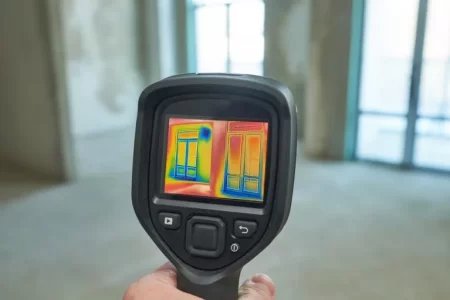Did you know that air leakage accounts for 15 to 25% of the heat loss from within a home? The uncontrolled airflow via cracks and openings in a building’s roof, walls, and floor is known as air leakage and it is quite common here in Australia.
Imagine how much money you could save on energy costs by preventing these air leakages. Luckily, Passive House is here! We provide proficient airtightness testing in Adelaide to help you achieve three crucial things:

Testing the airtightness (or air permeability) of an entire building is routine in Europe and North America. It is well documented that fully sealed dwellings show better performance in terms of energy efficiency and thermal comfort. The airtightness of Australian buildings is comparatively poor, contributing to poor energy efficiency and thermal comfort.
You can easily improve your indoor comfort as well as utility cost by preventing your expensive conditioned air from exiting your residential or commercial property.
Passive House Adelaide can accurately test airtightness in any building; even if it is an energy-efficient home or an aging draughty dwelling. Whether you have a large building or a small apartment our skilled and experienced technicians can carry out seamless airtightness testing in Coonawarra to help you solve your home’s airtightness issues.
We provide a wide range of airtightness testing services on both residential and commercial properties. Being a leading airtightness testing specialist in Adelaide, you can rely on us fully with our expert advice, solutions, and on-demand testing to deliver the appropriate outcomes required for your project.
Building standards and rating systems are being updated regularly to regulate and improve airtightness policy in the construction sector in Australia as Indoor Air Quality (IAQ) and building energy efficiency is becoming important aspect in the global and Australian construction industry.
For technical and complex establishments such as research facilities, hospitals, and laboratories, non-permeable building envelopes remain vital. The entry of unwanted external air into the workstation via the building envelope can be harmful to the research being conducted or the health of patients and residents.
We can evaluate the air permeability of your exterior building walls and facade to help you obtain Green Star credits. Our trained and experienced technicians can proficiently test to a variety of standards, including ATTMA TSL1 and TSL2, ISO 9972, ASTM E779, Passivhaus, and ASHRAE.
In addition to that, we use a combination of industry-proven techniques, including smoke testing and thermal imaging, to identify air leakage locations.
Passive House Adelaide uses advanced technology and superior techniques to analyze the air exchange performance of your building’s occupied spaces. In addition to that, we also examine building airtightness of building envelope leakage (BEL), which is often known as blower door testing. This is an important technique for determining air quality while developing methods to deal with “stale air” or “dead pockets.” The airtightness testing process is becoming increasingly crucial for building certification programs like Green Star.
Our specialists provide expert advice and solution based on the permeability issues of your building envelopes or façade. We may guide the design of the building envelope as part of our extended service to ensure that the detailed drawings define a fully continuous air and vapor barrier, which is the key to creating the appropriate airtight construction.
During the construction process, we evaluate the building envelope quantitatively. This is becoming increasingly essential for validating building techniques during construction and making things easier for the Green Building Council of Australia in providing Green Star credits for certification.
For expert guidance, solutions and on-demand testing for appropriate results get in touch with Passive House Adelaide today.
available from 9:00 – 18:00
Address: 21 Beatty St, Flinders Park, South Australia
© Copyright 2023 – All rights reserved